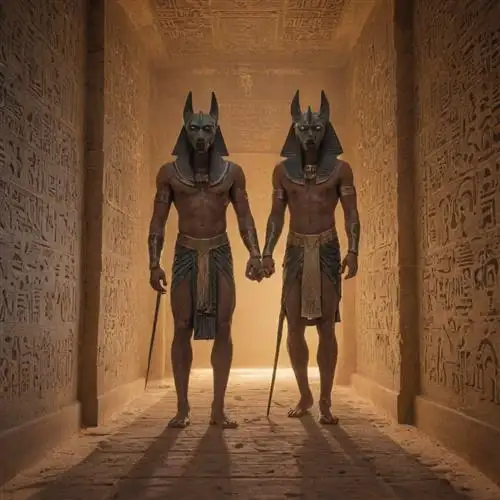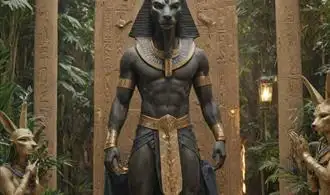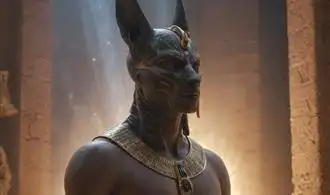
The Origin of Anubis
Anubis, the jackal-headed deity, holds a revered position in ancient Egyptian mythology. This enigmatic figure has captivated the imagination of scholars and enthusiasts alike, with his origins and significance deeply rooted in the cultural and religious fabric of the ancient Nile civilization. To delve into the secrets of Anubis is to uncover a tapestry of belief, symbolism, and the profound role he played in the Egyptian conception of the afterlife.
Anubis' origins can be traced back to the early dynastic period of ancient Egypt, where he emerged as a prominent figure in the pantheon of deities. Initially, he was associated with the process of embalming and the preparation of the dead for their journey into the afterlife. This role was crucial, as the Egyptians believed that the preservation of the physical body was essential for the continued existence of the soul.
One of the intriguing aspects of Anubis' origins is the connection between his jackal-like appearance and his funerary duties. The jackal was a common sight in the deserts and necropolis of ancient Egypt, and its nocturnal habits and prowling nature were thought to be symbolic of the transition between the world of the living and the realm of the dead. Anubis, with his canine-inspired features, was therefore seen as the guardian and protector of the deceased, guiding them safely through the perils of the underworld.
Anubis' role in the Egyptian conception of the afterlife extended beyond his duties as a embalmer and guide. He was also central to the ritual of the "weighing of the heart," a crucial step in the journey of the deceased. During this process, the heart of the individual was placed on a scale and weighed against the feather of Ma'at, the goddess of truth and justice. Anubis was responsible for overseeing this pivotal moment, ensuring the integrity of the judgment and the worthiness of the soul to pass into the afterlife.
The importance of Anubis in ancient Egyptian belief systems is further highlighted by his association with other significant deities. He was often paired with Osiris, the god of the underworld, and was considered a key figure in the mythological narrative surrounding the death and resurrection of Osiris. This connection to Osiris further solidified Anubis' role as a guardian and intermediary between the worlds of the living and the dead.
Anubis The Jackal Headed God
Anubis, the enigmatic jackal-headed deity, has captivated the imaginations of many for millennia. As one of the most iconic and revered Egyptian gods, Anubis' influence extends far beyond the confines of ancient Egypt, permeating pop culture, mythology, and the spiritual beliefs of countless individuals worldwide. In this in-depth exploration, we delve into the captivating secrets of Anubis, unearthing the profound insights that can forever transform your perspective on life, death, and the mysteries of the afterlife.
Anubis, the god of the dead, is deeply intertwined with the process of mummification and the journey of the soul into the afterlife. As the overseer of the embalming process, Anubis ensured the proper preparation of the deceased, guiding them through the intricate rituals that would ensure their safe passage to the next world. This profound connection to the transition from life to death is a testament to Anubis' role as a guardian and protector of the departed, a role that holds immense significance for those seeking solace and understanding in the face of mortality.
Beyond his role as the god of the dead, Anubis is also revered as a deity of transition, transformation, and rebirth. His dual nature, represented by the jackal and the dog, symbolizes the duality of life and death, the constant cycle of endings and new beginnings. This powerful symbolism offers profound insights into the nature of change, and the ability to embrace the inevitable transformations that shape our existence. By aligning oneself with the teachings of Anubis, individuals can cultivate a deeper understanding of the cycles of life, and find solace in the knowledge that even in the face of darkness, new beginnings and opportunities for growth always lie ahead.
Anubis' iconography is equally captivating, with the jackal-headed deity often depicted holding the crook and flail, symbols of royal authority and divine power. This imagery speaks to Anubis' role as a gatekeeper, a figure who stands at the threshold between the realms of the living and the dead, guiding souls through the complex and often daunting journey of the afterlife. For those seeking to deepen their understanding of the mysteries of death and the afterlife, the symbolism of Anubis offers a powerful lens through which to explore these profound questions.
Furthermore, Anubis' association with the color black, a hue often linked to fertility, regeneration, and the rich, fertile soil of the Nile, further cements his status as a deity of transformation and new beginnings. This connection to the cyclical nature of life and death, and the ever-evolving tapestry of existence, provides valuable insights for those seeking to navigate the complexities of their own personal journeys.
Anubis and the Afterlife
Anubis, the Egyptian god of the afterlife, holds a profound and intriguing connection to the journey of the deceased. As the guardian of the dead and the embalmer of mummies, Anubis played a crucial role in the ancient Egyptian conception of the afterlife. One of the most significant aspects of Anubis's relationship with the afterlife is his role in the judgment of the dead.
In the process of the "weighing of the heart," a central ritual in ancient Egyptian funerary practices, Anubis was responsible for overseeing the deceased's journey to the afterlife. During this ceremony, the heart of the deceased was weighed against the feather of Ma'at, the goddess of truth and justice. If the heart was found to be lighter than the feather, signifying a life lived in accordance with Ma'at's principles, the soul would be granted passage to the afterlife. Anubis's role as the guide and protector of the deceased during this critical moment was essential, ensuring the soul's safe passage into the afterlife.
Furthermore, Anubis was also responsible for the embalming process, a crucial step in the ancient Egyptian funerary rites. By carefully mummifying the deceased, Anubis ensured the preservation of the body, which was believed to be necessary for the soul's continued existence in the afterlife. The intricate process of mummification, overseen by Anubis, was a testament to the importance of the physical form in the ancient Egyptian conception of the afterlife.
Interestingly, Anubis's association with the afterlife extended beyond his role in the judgment and preparation of the deceased. He was also believed to be a psychopomp, a guide who accompanies the souls of the dead on their journey to the afterlife. This role further solidified Anubis's position as a pivotal figure in the ancient Egyptian understanding of the afterlife and the transition from the mortal world to the realm of the dead.
Anubis's connection to the afterlife was not limited to his specific duties and responsibilities. He was also seen as a symbol of protection and guidance, providing comfort and support to the deceased and their loved ones during this critical transition. This aspect of Anubis's character contributed to his widespread veneration and importance within the ancient Egyptian religious and cultural framework.
Anubis and Mummification
Anubis, the ancient Egyptian god of the dead, played a crucial role in the mummification process, guiding souls through the afterlife. As the patron deity of embalmers and guardian of the necropolis, Anubis' involvement in the intricate art of mummification was paramount. Let's delve into the secrets and significance of Anubis' connection with this sacred practice.
Anubis was responsible for the embalming and preparation of the deceased for their final journey. It was believed that he would oversee the mummification process, ensuring the proper preservation of the body. This meticulous task involved the removal of internal organs, the application of natron (a type of salt) for desiccation, and the careful wrapping of the body in linen bandages. Anubis' keen attention to detail and his expertise in the art of mummification were essential in safeguarding the deceased's physical form for the afterlife.
Moreover, Anubis played a vital role in the weighing of the heart ceremony, a crucial step in the journey to the afterlife. During this ritual, the deceased's heart was weighed against the feather of Ma'at, the goddess of truth and justice. If the heart was found to be pure and in balance, the individual was deemed worthy of passing through to the next life. Anubis, as the guide of the dead, would oversee this crucial judgment, ensuring the fairness and integrity of the process.
Anubis' association with mummification extended beyond the physical preparation of the body. He was also believed to protect and guide the deceased through the perils of the underworld, ensuring their safe passage to the afterlife. The jackal-headed god was often depicted standing guard at the entrance to the afterlife, ready to welcome and assist the deceased in their journey.
Anubis and the Weighing of the Heart
In the intricate tapestry of ancient Egyptian mythology, the figure of Anubis stands as a pivotal guardian of the afterlife. As the deity responsible for the ritual of the Weighing of the Heart, Anubis played a crucial role in determining the fate of the deceased, guiding them through the complexities of the afterlife. This sacred ceremony, known as the "Weighing of the Heart," was a fundamental aspect of the Egyptian belief system, offering a glimpse into the profound understanding of the soul's journey beyond the physical realm.
The Weighing of the Heart ceremony was a meticulous process, with Anubis overseeing the delicate balance between the individual's heart and the feather of Ma'at, the goddess of truth and justice. This symbolic act represented the evaluation of the deceased's moral and ethical conduct during their lifetime. The heart, believed to be the repository of the soul, was placed on one side of a scale, while the feather of Ma'at was placed on the other. If the heart was found to be heavier than the feather, it indicated the individual had lived a life out of alignment with the principles of Ma'at, and their soul would be subjected to a horrific fate. Conversely, if the heart was lighter than the feather, it signified a life lived in harmony with the divine order, granting the deceased passage into the afterlife.
Anubis, the jackal-headed deity, was responsible for overseeing this critical judgment. As the embalmer of the dead and the guide of souls, Anubis possessed a unique understanding of the delicate balance between the physical and spiritual realms. His presence at the Weighing of the Heart ceremony ensured the impartiality and integrity of the process, ensuring that the deceased received the just and righteous judgment they deserved.
The significance of the Weighing of the Heart ceremony cannot be overstated. It reflected the ancient Egyptians' profound reverence for the sanctity of the soul and their belief in the ongoing existence of the individual beyond the physical realm. This ritual was not merely a symbolic gesture but rather a deeply ingrained aspect of their cultural and spiritual identity, shaping their understanding of the afterlife and the cosmic order that governed the universe.















